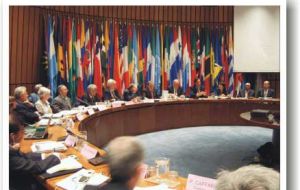MercoPress. South Atlantic News Agency
Cepal forecasts commodities boom to continue 5/10 years
 Latam booming but 200 m. below poverty line
Latam booming but 200 m. below poverty line Latinamerica is poised to enjoy exceptionally high prices for its exports during the next five to ten years given the growing demand for commodities from China and India, according to a report from the United Nations Economic Commission for Latinamerica and the Caribbean, Cepal.
Commodities prices have increased at an annual rate of 32% since 2003 and countries most favored following on the Cepal "International insertion program" are Chile, Peru, Cuba, Brazil, Costa Rica and Argentina, the region's main suppliers of the Asian market. However this commodities boom will not guarantee stable growth on the long term given shortcomings in innovation, human resources and social cohesion, warned Cepal's Executive Secretary, Jose Luis Machinea. In the short term regional economies are not threatened by the "financial turbulences" given the massive rescue effort from the world's leading countries central banks, added Machinea. He said that with the exception of Argentina all countries in the region have reduced considerably their financial risks by cutting on short term debt and increasing international reserves. For example, Brazil's international reserves are above 100 billion US dollars and Chile has virtually no short term debt. "This favorable scenario should enable to cut the number of poor people to less than 200 million and even more the indigent index that has dropped 20% in the last four years" said Machinea who nevertheless anticipated no abrupt drop in these indexes in the coming years. But Cepal also warned that if the opportunity is not turned into an advantage Latinamerica will continue to grow below its potential and social cohesion will suffer. Therefore governments must ensure that income from commodities effectively finances a productive industrialization, "which requires of policies that are not being currently instrumented". Challenges also include upgrading infrastructure, improving higher education and social benefits extensive to all populations irrespective of labor markets. Infrastructure shortcomings condemn almost 50 million Latinamericans to live in extreme poverty and generate massive losses to potential growth, according to the World Economic Forum.




Top Comments
Disclaimer & comment rulesCommenting for this story is now closed.
If you have a Facebook account, become a fan and comment on our Facebook Page!